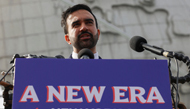▶ Income Inequality and N.R.A. Dominance May Not Last Forever
▶ JOE NOCERA
What prompts these thoughts are two papers that landed on my desk recently. Although they tackle very different issues, they have one thing in common: They imagine a future that breaks from the present path.
The first is a draft of a speech given earlier this month at TEDMED by Daniel Webster, the director of the Johns Hopkins Center for Gun Policy and Research. (TEDMED is associated with TED Talks.) The second is an article in the latest edition of the Harvard Business Review by Roger Martin, the former dean of the Rotman School of Management at the University of Toronto.
Webster’s speech lays out an agenda that he predicts will reduce the murder rate by 30 to 50 percent within 20 years. “I don’t think that our current level of gun violence is here to stay,” he declares in the draft of the speech. Martin’s article is about how the rise of the “talent economy,” as he calls it, has helped further income inequality. But he doesn’t believe a high level of income inequality is an inevitable part of our future.
Let’s tackle Webster first. Politically, he told me, “It’s a loser to call for a gun ban.” Instead, his reforms would make it more difficult for criminals to get their hands on guns. Using background checks, he would keep guns away from people who have a history of violence. He would raise the age of gun ownership to 21. (Webster notes that homicides peak between the ages of 18 and 20.) He would pass laws that make gun dealers more accountable, including “requiring business practices that prevent guns being diverted to criminals.” And he would mandate something called microstamping, “which would make it possible to trace a gun used in a crime to its first purchaser.”
When I asked him why he thought these changes would eventually take place, given the inability of the Senate to pass a background check bill after Newtown, he pointed to polls that show the vast majority of gun owners favor such changes.
“The N.R.A. has been very successful in controlling the conversation and making it about a cultural war,” he told me. “But I believe that narrative won’t persist.” The key, he says, is to change the conversation so that it is about pro- and anti-crime instead of pro- and anti-gun. Once that happens, “gun owners will start to demand changes.” He added, “I think that ultimately that idea will prevail, and it will be a pretty mainstream idea.”
Now to Roger Martin. His essay traces the way “talent” came to replace labor and capital as the most important factor in the economy, so much so that those who were part of the talent economy could become billionaires even as the median income stalled and then slipped back. Chief executives, who have gorged on stock options, are part of the talent economy, and so are hedge fund managers, who charge the infamous “2 and 20” (meaning a 2 percent management fee and 20 percent of the profits), which ensures their wealth no matter how poorly their investors do. The interests of such talent, in his view, simply don’t align with the interests of the rest of us.
Like Webster, Martin also proposed a series of changes to “correct the imbalance,” as he puts it. He suggests that pension funds should see that they are best served when they do not hand capital to hedge funds, for instance. And he wants talent to show “self-restraint.”
When I told him that seemed unlikely, he told me he thought we were approaching a moment like 1935, when, after years of letting labor fend for itself, the government passed laws that protected labor and helped bring about the rise of the labor movement.
If talent doesn’t start taking the rest of the country into account, he said, he feared that the government would once again take significant action to level the playing field.
Given the current political paralysis, I asked, what might bring that about? “Another boom and crash,” he said.
Martin clearly sees his article as a warning to corporate executives and others who are part of the 1 percent. And maybe, just maybe, it will take hold. After all, not long after his article was published, Calpers, the huge California pension fund, announced that it was going to eliminate hedge funds from its portfolio. There’s hope yet.
스마터리빙
more [ 건강]
[ 건강]이제 혈관 건강도 챙기자!
[현대해운]우리 눈에 보이지 않기 때문에 혈관 건강을 챙기는 것은 결코 쉽지 않은데요. 여러분은 혈관 건강을 유지하기 위해 어떤 노력을 하시나요?
 [ 건강]
[ 건강]내 몸이 건강해지는 과일궁합
 [ 라이프]
[ 라이프]벌레야 물럿거라! 천연 해충제 만들기
 [ 건강]
[ 건강]혈압 낮추는데 좋은 식품
[현대해운]혈관 건강은 주로 노화가 진행되면서 지켜야 할 문제라고 인식되어 왔습니다. 최근 생활 패턴과 식생활의 변화로 혈관의 노화 진행이 빨라지고
사람·사람들
more
“이념 넘어 상호 존중, 한반도 평화의 기반”
장병우 LA 평통 신임회장이 평통의 역할을 강조하고 있다. [박상혁 기자]“이념보다 중요한 건 상호 존중입니다. 서로를 인정하는 데서 한반도 …

센터메디컬그룹 제4회 ‘이웃섬김’ 시니어 골프대회 성황
센터메디컬그룹(Center IPA)이 주최한 제4회‘이웃섬김’ 시니어 골프대회가 지난 3일 부에나팍의 로스 코요테스 컨트리클럽에서 130여 명…
김민선 이민사박물관장 ‘백악관 역사위원’ 위촉
미주한인이민사박물관의 김민선(사진) 관장이 4일 ‘백악관 역사위원회’자문위원에 위촉됐다. 김 관장은 향후 3년간 백악관의 역사 보존, 건축물 …
미주 박정희 기념사업회 14일 탄신 108주년 행…
미주 박정희대통령기념사업회(회장 이재권)가 박정희 대통령 탄신 108주년 기념 축하행사를 오는 14일(금) 오후 5시30분 LA 아로마센터 5…
‘LA 한인 재즈콰이어’ 15일 창단 1주년 공연
LA 한인 최초 재즈합창단 ‘LA 재즈콰이어’(단장 한성현·음악감독 김영균·지휘자 강진한)가 오는 15일 오후 5시 LA 옥스포드 팔레스 호텔…
많이 본 기사
- ‘김승규 vs 조현우’ 불붙은 수문장 경쟁… 홍명보 감독의 선택은
- 저소득층들을 위한 아파트 설명회
- “시니어 낙상 예방 이렇게 하세요”
- ‘발의안 50’ 압도적 통과… 전국 지방선거 민주 ‘완승’
- ‘대대적 이민 단속’ LA 일원 곳곳 재개
- 조영주 제독 OC 간증 집회 가져
- 어바인 해병대 후원회 장남감 기부 행사 열려
- 트리 타 가주 하원의원 시니어 사기 방지 행사
- “4천만 땡겨달라”던 김숙, ‘100억설’ 송은이보다 재산 多 “생각보다 많이 모아”
- 멕시코 여성 대통령, 거리서 취객에 성추행 당해
- 발로 뻥뻥! 택시안서 소변 한국인 관광객 추태 ‘발칵’
- 영 김(가주 40지구), 당내 경쟁 불가피… 데이브 민(가주 47지구)은 유리
- “갤럭시 워치 덕분에 살았다” 화제
- 당뇨·고혈압 있다면 비만 치료제보다 수술 고려
- ITZY 류진, 본격 배우 도전.. ‘지상의 밤’ 10월 크랭크업
- 한인 여성 정치인들 약진… “풀뿌리 정치력 강화”
- 지드래곤 “은퇴할 수도 있었다”…2년 전 마약 의혹 심정 밝혀
- 연말까지 해외직구 특별 단속
- ‘케이팝 데몬 헌터스’ 속편 나온다.. “2029년 공개 목표”
- “급등한 가주 주택보험료, 부당한 방식 인상”
- 정부 셧다운 ‘역대 최장’ 36일 신기록
- 중국인 부동산 규제 연방 법원, ‘합헌’ 판결
- “건강플랜 선택은 ‘유나이티드 헬스케어’와 함께”
- 화물기 추락·폭발 참사…11명 사망·20명 부상
- CGV 문 닫은 타운 마당몰… ‘리젠시 극장’개관
- MLS서 석 달 뛴 손흥민 ‘올해의 신인’ 투표서 2위
- 연방정부 셧다운에 SBA 대출 ‘올스톱’
- 다시 덮친 ‘AI 거품’ 공포… 글로벌 증시 급락
- 원·달러 환율, 1,450원까지 ‘터치’
- 오클라호마시티, 클리퍼스 대파… 개막 8연승 ‘질주’
- IBM, 직원 수천명 감원 아마존·메타 등 이어
- 전기항공기 업체 ‘베타’ 증시 상장·아마존 투자
- 생명보험 현금가치 활용한 은퇴연금 전략
- 메디케이드 받는 불체자 색출한다
- [여명] 깐부의 시대, 깐부의 정치
- 민간고용 4만2,000명 늘어… 3개월만에 증가
- 투자 계좌ㆍ고정 지수 연금 어디에 맡길까?
- 사소하지 않은 일상
- 버크셔, 올해 들어 자사주 매입 중단
- “이념 넘어 상호 존중, 한반도 평화의 기반”
- 주택 보험료 영향 요인… 집값보다 ‘주소’가 더 영향
- 구입비 낮은 매뉴팩처드(공장에서 제작돼 설치되는 주택) 홈… ‘부동산·동산’에 따라 큰 차이
- BBQ, 전국 매장 확대에 가속
- 2025 하반기 미국 주택 시장의 동향 분석
- 세계한인의 날 유공자 훈장 및 증서 전달식
- [왈가 왈부] ‘김장 물가 점검’ 김 총리 “상인분들도”… 어쩌란 말이죠
- [윌셔에서] 빛바랜 사진
- KCPAC 순회 강연- 주제
- 물불 안가리는 이민단속…유치원 건물도 들어가 교사 체포
- ‘크레아틴 보충제’ 먹어야 하나… “근력 운동과 병행해야”
1/5지식톡

-
 테슬라 자동차 시트커버 장착
0
테슬라 자동차 시트커버 장착
0테슬라 시트커버, 사놓고 아직 못 씌우셨죠?장착이 생각보다 쉽지 않습니다.20년 경력 전문가에게 맡기세요 — 깔끔하고 딱 맞게 장착해드립니다!장착비용:앞좌석: $40뒷좌석: $60앞·뒷좌석 …
-
 식당용 부탄가스
0
식당용 부탄가스
0식당용 부탄가스 홀세일 합니다 로스앤젤레스 다운타운 픽업 가능 안녕 하세요?강아지 & 고양이 모든 애완동물 / 반려동물 식품 & 모든 애완동물/반려동물 관련 제품들 전문적으로 홀세일/취급하는 회사 입니다 100% …
-
 ACSL 국제 컴퓨터 과학 대회, …
0
ACSL 국제 컴퓨터 과학 대회, …
0웹사이트 : www.eduspot.co.kr 카카오톡 상담하기 : https://pf.kakao.com/_BEQWxb블로그 : https://blog.naver.com/eduspotmain안녕하세요, 에듀스팟입니다…
-
 바디프렌드 안마의자 창고 리퍼브 세…
0
바디프렌드 안마의자 창고 리퍼브 세…
0거의 새제품급 리퍼브 안마의자 대방출 한다고 합니다!8월 23일(토)…24일(일) 단 이틀!특가 판매가Famille: $500 ~ $1,000Falcon: $1,500 ~ $2,500픽업 & 배송직접 픽업 가능LA…
-
 바디프렌드 안마의자 창고 리퍼브 세…
0
바디프렌드 안마의자 창고 리퍼브 세…
0거의 새제품급 리퍼브 안마의자 대방출 한다고 합니다!8월 23일(토)…24일(일) 단 이틀!특가 판매가Famille: $500 ~ $1,000Falcon: $1,500 ~ $2,500픽업 & 배송직접 픽업 가능LA…
케이타운 1번가
오피니언
 이상희 UC 리버사이드 교수 인류학
이상희 UC 리버사이드 교수 인류학 사소하지 않은 일상
 윤민혁 서울경제 실리콘밸리특파원
윤민혁 서울경제 실리콘밸리특파원 [실리콘밸리 View] MS 독점 벗어난 오픈AI, AWS 대형 계약
 박태준 서울경제TV 보도본부장
박태준 서울경제TV 보도본부장 [여명] 깐부의 시대, 깐부의 정치
 허경옥 수필가
허경옥 수필가 [윌셔에서] 빛바랜 사진
 양홍주 / 한국일보 논설위원
양홍주 / 한국일보 논설위원 [지평선] 작은 거인 야마모토

[왈가 왈부] ‘김장 물가 점검’ 김 총리 “상인분들도”… 어쩌란 말이죠
 정숙희 논설위원
정숙희 논설위원트럼프 와이너리
 파리드 자카리아 워싱턴포스트 칼럼니스트 / CNN ‘GPS’ 호스트
파리드 자카리아 워싱턴포스트 칼럼니스트 / CNN ‘GPS’ 호스트 트럼프는 중국의 규칙을 따른다
 김동찬 시민참여센터 대표
김동찬 시민참여센터 대표 [미국은 지금] 복합적 위기 어떻게 대처해야 하나
1/3지사별 뉴스

역대 최초 무슬림 뉴욕시장 탄생… 맘다니 과반 압승
초미의 관심을 모았던 뉴욕시장 본선거에서 조란 맘다니 민주당 후보가 승리하면서 역대 최초의 무슬림 뉴욕시장이 탄생했다. 초박빙 판세로 여겨졌던…
메디케이드 받는 불체자 색출한다

“메디케어 파트 D 점검·가입 도와드려요”
워싱턴 한인복지센터(이사장 김진아)가 지난달 15일 시작된 메디케어 파트 D 연례 점검 및 가입 서비스를 제공하고 있다. 메디케어 파트 D(…
한국 ‘전통공예 장인들의 숨결’

‘월가 황제’ 다이먼, 맘다니에 “디트로이트 시장에게 배우길”
‘월가의 황제’로 불리는 제이미 다이먼 JP모건체이스 회장이 사회주의자를 자처하는 조란 맘다니 미국 뉴욕시장 당선인을 향해 ‘디트로이트 시장에…
22기 SF*덴버 평통 111명 확정

오늘 하루 이 창 열지 않음 닫기 


















































.png)


댓글 안에 당신의 성숙함도 담아 주세요.
'오늘의 한마디'는 기사에 대하여 자신의 생각을 말하고 남의 생각을 들으며 서로 다양한 의견을 나누는 공간입니다. 그러나 간혹 불건전한 내용을 올리시는 분들이 계셔서 건전한 인터넷문화 정착을 위해 아래와 같은 운영원칙을 적용합니다.
자체 모니터링을 통해 아래에 해당하는 내용이 포함된 댓글이 발견되면 예고없이 삭제 조치를 하겠습니다.
불건전한 댓글을 올리거나, 이름에 비속어 및 상대방의 불쾌감을 주는 단어를 사용, 유명인 또는 특정 일반인을 사칭하는 경우 이용에 대한 차단 제재를 받을 수 있습니다. 차단될 경우, 일주일간 댓글을 달수 없게 됩니다.
명예훼손, 개인정보 유출, 욕설 등 법률에 위반되는 댓글은 관계 법령에 의거 민형사상 처벌을 받을 수 있으니 이용에 주의를 부탁드립니다.
Close
x